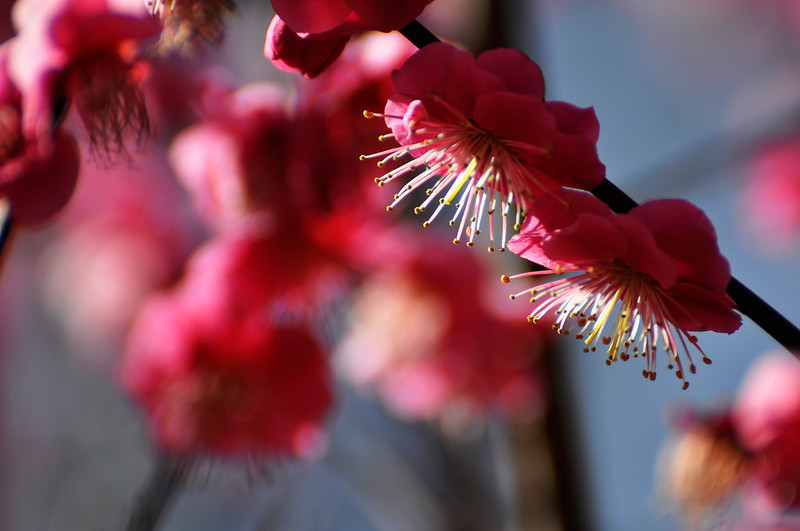Jan 27, 2017
Plum Blossom Viewing in Nagoya – Top Umemi Spots!
Ume is not just half of an “umeshu,” a Japanese liqueur made from unripe and green ume fruits. It is quite a lovely tree. “Prunus mume” is the tree species more commonly referred to as a Chinese plum or Japanese apricot tree. The tree produces a delicious fruit usually referred to as a plum but is closer to an apricot. You may know it best as “umeshu” if you have an affinity for too-sweet alcoholic drinks, or “umeboshi,” if you eat bento boxes with any regularity, or have a fondness for sour food. Ume flavor is available in a wide variety of candies, juices, alcohol, and sauces in Japan. Another product of the ume tree is plum blossoms, which brings us to the topic of this article; plum Blossom viewing and the best places to do that in Nagoya.
You may be more familiar with the word “hanami,” or cherry blossom viewing, but there is a different term for viewing ume blossoms; “umemi / 梅見.” Umemi usually begins in late winter and early spring, just before the famous “sakura” cherry blossoms. Their timing makes them a herald of spring, and traditionally the Japanese have loved the strong, sweet smell of the pink, red, and white flowers. The peak period for viewing the blossoms will depend on the variety of trees, but the season is from early February until late March. Many locations will hold a festival during their specific peak period, and catching that will be well worth the trip!
Top Umemi Spots around Nagoya
If you are interested in braving the lingering cold of winter and enjoying your day under the plum blossoms this year, you can try one of these locations.
Higashiyama Zoo and Botanical Gardens
On the yellow line, a trip to Nagoya’s Higashiyama Zoo and Botanical Gardens, located near Higashiyama Koen Station, is a very convenient option for enjoying umemi. If you are looking for a quick and easy way, this might be your best option, and with 200 trees in 30 different varieties, you are likely to see blossoms from January until March, though the ideal time is from mid-February to early March.
Higashiyama Park Station on the Higashiyama (yellow) Subway Line
3-70 Higashiyama Motomachi, Chikusa Ward, Nagoya, Aichi Prefecture 464-0804 (google map)
052-782-2111
Higashiyama Zoo and Botanical Gardens (Japanese)
Nagoya Castle (and Meijo Park)
Nagoya Castle is a beautiful symbol of Nagoya and a classic landmark of historical significance. It was built in 1612 by Tokugawa Ieyasu, Nagoya’s most famous resident, but rebuilt after the war knocked it down. The surrounding grounds, including Meijo-Koen Park, hold many exciting things; most relevant here are the number of gardens. A castle is a convenient place for umemi, but with only 100 trees in 13 varieties, it is best visited from middle February to early March.
Shiyakusho Station on the Meijo (purple) Subway Line. Use exit 7 (castle)
Meijo Koen Station on the Meijo (purple) Subway Line. Use exit 2. Walk west (park)
1-1 Honmaru, Naka Ward, Nagoya, Aichi Prefecture 460-0031 (google map)
052-231-1700
www.nagoyajo.city.nagoya.jp
Nagoya Agriculture Center
The Nagoya Agriculture Center is located in Tenpaku Ward. It is free to enjoy the cafe and shops selling a variety of organic vegetables and other healthy foods, as well as greenhouses and a model farm complete with livestock. Some sections require a fee to use, but the grounds are perfect for picnics,l though a bit crowded during blossom season. This location features 800 trees in 12 different varieties, including some very lovely and distinctive hanging types. Best visited from middle February to early March.
Hirabari Station on the Tsurumai (blue) Line. 15 minutes walk east
2872-3 tenpaku cho oozawa hirabari kuroi, Tenpaku Ward, Nagoya, Aichi Prefecture 468-0021 (google map)
052-801-5221
www.city.nagoya.jp… (Japanese)
Mt Togoku (Togokusan) Fruit Park
Togokusan Fruit Park is an agricultural park dedicated to outdoor and agricultural education. It features 15 separate orchards of local and “world” fruits, as well as a fishing area, a Japanese garden, and fields full of seasonal flowers and plants. They, of course, also offer restaurants and shops. The park features 200 trees in 21 varieties, allowing blossoms from January until March, though the ideal time is from mid-February to early March.
2110 Togoku, Kamishidami, Moriyama-Ku, Nagoya, Aichi Prefecture 463-0001, Japan (google map)
052-736-3344
www.fruitpark.org (Japanese)
Sori Park (Sohri Midori to Hana no Fureai-koen)
This park is built around a water retention pond on the Chita Penninsula. The park has a stunning 4,600 ume trees in 21 varieties, making this an excellent place to visit from January until March, though the ideal time is from mid-February to early March. The ideal time is made more ideal by the matsuri (festival) held here during this time, where you can view stage events, and outdoor tea ceremonies held under the blossoms.
2017 schedule for the matsuri is Saturday, February 11, until Sunday, March 12. Events vary, see website for details… sorry; it is not in English! http://www.city.chita.lg.jp/docs/2016121200043/
Asakura Station on Meitetsu Tokoname Line. Then Chita Bus bound for Sohri. Get off at Ume-no-yakata-guchi.
Walk east
3-101 Sohridai, Chita-shi, Aichi 478-0018 (google map)
05-62-54-2911
www.medias.ne.jp/~umehouse
Image: flickr.com “Plum blossoms(Hanegi Park)” by kanegen (CC BY-NC-SA 2.0)


About the author